The use of intersemiotic and interlingual translation activities in an efl classroom
DOI:
https://doi.org/10.29051/rel.v3.n2.2017.9229Keywords:
Translation and teaching methods. Translation categories. Translation exercises. English as a foreign language teaching.Abstract
The objective of this paper is to analyze the use of translation as a tool in EFL teaching. Through the application of three activities involving the interlingual and the intersemiotic translation categories proposed by Jakobson (1958, 2000), field notes and the analysis of assessment results, the impact of the use of translation as a teaching tool on students’ learning was investigated. The theoretical framework used involves scholars such as Leffa (1988), Romanelli (2006), Lucindo (2006, 2009) and Malmkjaer (1998). Data organization indicates a qualitative methodology and an action research. The corpus is organized by the students’ answers to activities and the answers to the questionnaires. Results have shown that the study of translation categories as a tool in EFL teaching, when used adequately and with specific goals, can be helpful for teachers and students, making the use of translation in this context justifiable and positive.
Downloads
References
AUMONT, Jacques. A imagem. Campinas: Papirus, 1993. Tradução: Estela dos Santos Abreu e Cláudio C. Santoro.
BRANCO, Sinara Oliveira. Teorias da tradução e o ensino de língua estrangeira. Revista Horizontes de Linguística Aplicada, v. 8, n. 2, p. 185, 2009.
BRANCO, Sinara Oliveira. The application of intersemiotic translation combined with multimodal activities in the English as a foreign language classroom. Revista Brasileira de Linguística Aplicada, v. 14, n. 2, p. 293-312, 2014.
JAKOBSON, Roman. On linguistic aspects of translation. In: VENUTI, Lawrence (Org.). The translation studies reader. London: Routledge, 2000. p. 113-118.
KIMINAMI, Aline Yuri; CANTAROTTI, Aline. Tradução e Ensino de Língua Estrangeira – Possibilidades e direcionamentos. In: CARVALHO, Tatiana de Lourenço. PONTES, Valdecy de Oliveira (Org.). Tradução e ensino de línguas - Desafios e perspectivas. Mossoró: UERN, 2014. p. 40-54.
LEFFA, Vilson J. Metodologia do ensino de línguas. In: BOHN, H. I.; VANDRESEN, P. Tópicos em linguística aplicada: O ensino de línguas estrangeiras. Florianópolis: Ed. da UFSC, 1988. p. 211-236.
LUCINDO, Emy Soares. Tradução e ensino de línguas estrangeiras. Scientia Traductionis, Santa Catarina, n. 3, 2006.
MALMKJAER, Kirsten (Org.) Translation & language teaching. Reino Unido: St Jerome Publishng, 1998. p. 1-11.
MALMKJAER, Kirsten. Language learning and translation. In: GAMBIER, Yves; VAN DOORSLAER, Luc (Ed.). Handbook of translation studies. John Benjamins Publishing, 2010. p.185-190
PEREIRA, Elisabete Francisca de Oliveira. O Papel da Língua Materna na aquisição da língua estrangeira. Revista Inter Ação, v. 26, n. 2, p. 53-62, 2007.
POPOVIC, Radmila. The place of translation in language teaching. Bridges, v. 5, p. 3-8, 2001.
RICHARDS, Jack C.; RODGERS, Theodore S. Approaches and methods in language teaching: a description and analysis. Cambridge: Cambridge University Press, 1986.
ROMANELLI, Sergio. Traduzir ou não traduzir em sala de aula? Eis a questão. Inventário (UFBA), Salvador, v. 05, não paginado, 2006.
ROMANELLI, Sergio. O uso da tradução no ensino-aprendizagem das línguas estrangeiras. Revista Horizontes de Linguística Aplicada, v. 8, n. 2, p. 200, 2009.
SVÄRD, Ann-Christin. The challenge of mixed-ability classes: How should upper secondary English teachers work in order to help the weaker students? Trabalho de conclusão de curso, Högskolan för lärande och kommunikation, Jönköping University/Suécia, 2007.
TEIXEIRA, Augusto Francisco. O pós-método e o ensino de língua inglesa. Revista Avepalavra, v. 11, n. 1, 2011.
Downloads
Published
How to Cite
Issue
Section
License
Os manuscritos aceitos e publicados são de propriedade da Revista EntreLínguas. Os artigos publicados e as referências citadas na Revista EntreLínguas são de inteira responsabilidade de seus autores.
Transferência de direitos autorais – autorização para publicação
Caso o artigo submetido seja aprovado para publicação, já fica acordado que o(s) autor(es) autoriza(m) a UNESP a reproduzi-lo e publicá-lo na EntreLínguas, entendendo-se os termos “reprodução” e “publicação” conforme definição respectivamente dos incisos VI e I do artigo 5° da Lei 9610/98. O artigo poderá ser acessado pela rede mundial de computadores (Internet), sendo permitidas, a título gratuito, a consulta e a reprodução de exemplar do artigo para uso próprio de quem a consulta, desde que haja a citação ao texto consultado. Essa autorização de publicação 328 EntreLínguas, Araraquara, v. 1, n .2, p. 323-328, jul./dez. 2015 não tem limitação de tempo, ficando a UNESP responsável pela manutenção da identificação do(s) autor(es) do artigo. Os artigos publicados e as referências citadas na Revista EntreLínguas são de inteira responsabilidade de seus autores.











